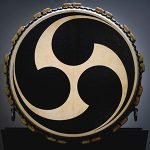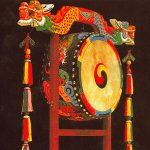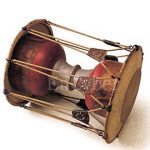
Japanese Taiko
Taiko is a general term for drumming. The Japanese tradition offers many different types and sizes of taikos. The thunderous sound of the taiko was not only used to represent Buddah’s voice in the temple or to imitate the wind and ocean, it’s rumbling was also used from Japan’s earliest days to frighten and intimidate enemies and to call its own troops to arms. Within the last hundred years, Taiko has gained an international following. Ondekoza and Kodo are two forerunners of today’s Taiko tradition. They fascinate with their traditional methods. They have also mastered the art of seducing the audience through their exceptional musical ability and the optical accompaniment. Taiko, with its precise articulated rhythms and movements is deeply rooted in Japanese culture. With its ability to touch the soul and stir up emotions it has crossed international and cultural boundaries. One beat permeates room and audience.

South Korean Buk
The Buk were traditionally played in the Buddhist monasteries in China, Korea and Japan and still appears in South Korean folk music. Multiple drums (5 for Obuk, 3 for Sambuk) are placed behind and to the side so that simple rhythms can be interpreted in manifold ways through dance.

South Korean Changgo
Changgo, or hourglass drums, were brought form China to Korea over 1000 years ago and is now an integral part of Korean music. A depiction of this drum appears on a bell dating back to 668 AD. In 1758 the Changgos appear in pictures of Korean history. The hourglass drum Changgo is a instrument of shaman and folk music. The two different drumheads symbolise the gates to the here and now and to the afterlife.

Swiss Hang
The hang is a very young instrument created by the steel drum maker Felix Rohner in Berne, Switzerland. Hang means hand in the Bernese dialect and the drum is named so because it is played with the hand. The drum can produce 7-8 different notes and can either be used to play melodies or for percussive tones.
